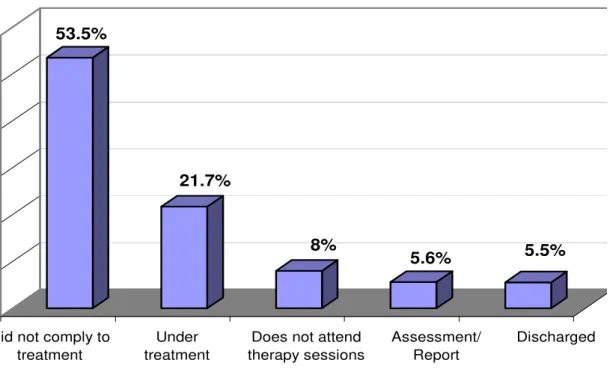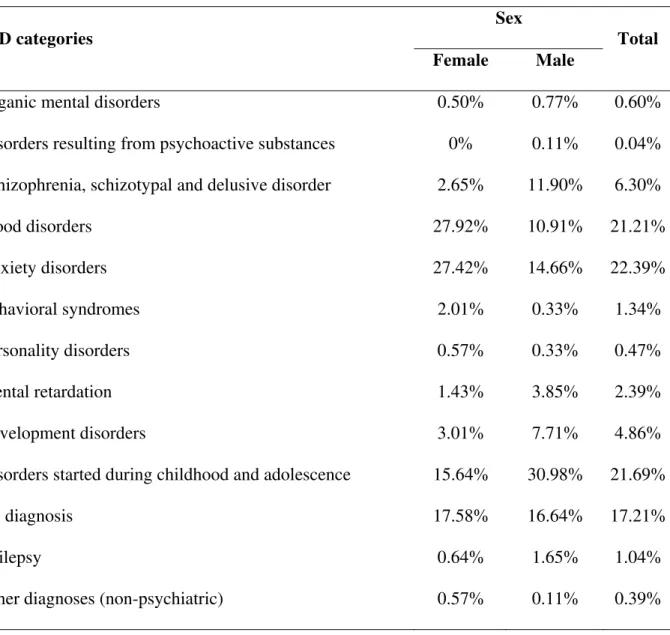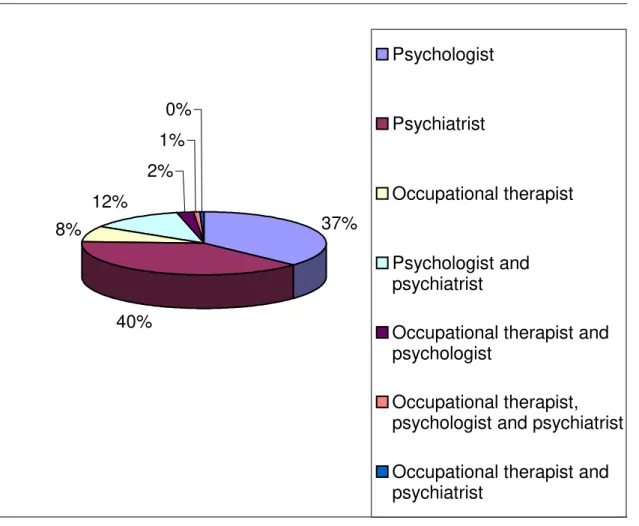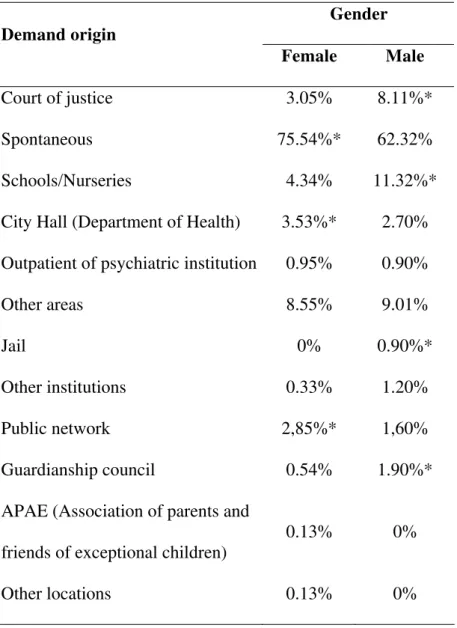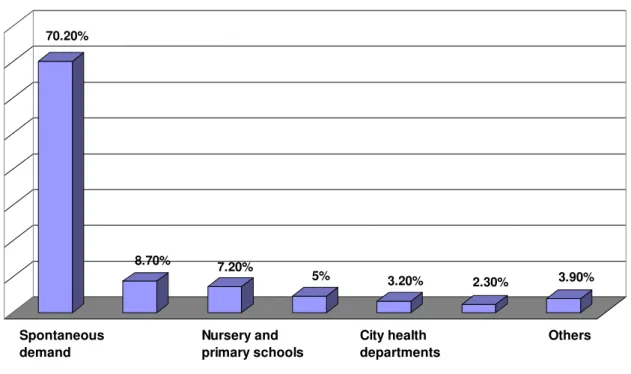Original article
Epidemiological characterization of the users of Casa Aberta, a psychosocial attention center
Cátula da Luz Pelisoli* Ângela Kunzler Moreira**
* Undergraduate student, Psychology school, Universidade do Vale do Rio dos Sinos (UNISINOS), corresponding author.
** MA. Psychologist, psychosocial attention center Casa Aberta. Professor, Faculdade Cenecista de Osório, RS, Brazil.
INTRODUCTION
Patients who look for mental health care have been referred to psychosocial attention services, which have been replacing the psychiatric hospitals, especially after the psychiatric deinstitutionalization.
The model centered in mental health care assistance based on hospitals started to be criticized after the 1970s,1 when practices of violence and exclusion became evident. In the mid 1980s, with the influence from the Italian psychiatry and the end of the dictatorial period in Brazil, new forms of psychiatric intervention gained momentum.
The sanitary proposal to approach mental illnesses, which intended to take mental impaired people out of the city, started to be replaced by an idea of deinstitutionalization. For this model based on isolation to be replaced, procedures and services that are capable of supplying this demand are required. Such services should work as a counterpoint to psychiatric hospitals. They should have open spaces, where an interdisciplinary team could reflect upon diagnoses and the possibilities of using therapeutic resources, both psychopharmacologic and psychotherapic.2
After 1992, when the Psychiatric reform law was approved in the state of Rio Grande do Sul, southern Brazil, new services were offered following the idea of transforming the mental care services into regional or sectorial units, and reducing the number of people assisted in the state. In October, the Casa Aberta (open house) was inaugurated as a Centro de Saúde Mental (Mental Health Center), later registered as a Centro de Atenção Psicossocial (Psychosocial Attention Center – CAPS).3
The Ministry of Health defines a CAPS as “an open and communitarian health service from the Unified Health System (Sistema Único de Saúde). It is a reference place for the treatment of people who suffer with mental disorders, psychoses, severe neurosis and other conditions, in cases where severity or persistence justify the individual’s permanence in a place of intensive,
through work, leisure, practice of civil rights and strengthening of familial and communitarian bonds are also fostered (p.13).4
Casa Aberta is a public institution that provides about 6,000 visits divided into therapy groups composed of children, adolescents, feelings, depressive patients, bipolar disorder patients, carriers of severe and persistent psychic disorders, groups that take similar medication, families and others, besides individual clinical assistance.
The other services are responsible for implementing new devices, reflecting and evaluating their effectiveness so that no “new confinements and hegemonies” are created.1 Such services, however, have not been considered as effective as they should be, having some difficulties in providing an effective assistance that would allow patients to live in proper conditions within their community.5 The World Health Organization (WHO) and the Ministry of Health have proposed an assessment of such services.
Casa Aberta has been implementing the evaluation proposed by means of research practices, as the one proposed in the present study. The main goal of the present study is to outline the
institution user’s profile.
METHODOLOGY
Ethical and functional procedures
combined treatments); and demand, which indicates what institution referred the patient to the CAPS. Data were stored in SPSS 8.0 software files.
All individuals who looked for assistance at the CAPS after 2001 entered the study. A limit date was set as exclusion criteria.
Records that did not mention any visits after this date were filed and not assessed. This study did not receive financial support.
As the institution does not have an ethical committee, this study was evaluated by the team members, who discussed and analyzed the project during meetings. The authors are responsible for keeping information secret and participants’ privacy. We opted for obtaining a free and informed consent from participants who were under treatment, however, it was not possible to obtain consent from patients who were lost or discharged. Individuals’ information was not revealed and
participants were not identified.
Participants
2,470 individuals were included in the study; further description on participants is provided in the results section. These individuals looked for the service at some time in the institution history and returned at least once after the cut-off date of December 31, 2000.
Methods
RESULTS
As to the variable sex, 59.6% (n = 1,472) of participants were female. Mean age was 30.35 years (SD = 59.52; median = 29.50; mode = 7) ranging from 1 to 94 years-old.
The most frequent occupations reported were: student (27.4%, n = 676), house worker (13%, n = 320), housemaid (2.5%, n = 63), retired (1.9%, n = 47) and farm worker (1.7%, n = 43).
The number of visits per patient varied from one to 171, mean = 6.77, median = 3 and mode = 1. Of these, 55.3% (n=1,357) were present in up to three visits.
Figure 1 shows the results for the status variable. 54% of patients (n = 1,322) evaded the treatment and 5.9% (n = 145) of registered patients had already been admitted to hospital due to psychiatric events.
53.5%
21.7%
8%
5.6% 5.5%
Did not comply to treatment
Do not frequent therapy sessions
Discharged
Did not comply to treatment
Under treatment
Does not attend therapy sessions Does not attend therapy sessions Does not attend therapy sessions
Assessment/ Report
Discharged
Figure 1 - Status as to treatment
quantitatively relevant diagnostic hypotheses for women were in the categories of mood disorders (affective) and neurotic disorders related to stress and of somatic origin.
Table 1 - Distribution of diagnostic categories according to sex
Sex ICD categories
Female Male Total
Organic mental disorders 0.50% 0.77% 0.60%
Disorders resulting from psychoactive substances 0% 0.11% 0.04% Schizophrenia, schizotypal and delusive disorder 2.65% 11.90% 6.30%
Mood disorders 27.92% 10.91% 21.21%
Anxiety disorders 27.42% 14.66% 22.39%
Behavioral syndromes 2.01% 0.33% 1.34%
Personality disorders 0.57% 0.33% 0.47%
Mental retardation 1.43% 3.85% 2.39%
Development disorders 3.01% 7.71% 4.86%
Disorders started during childhood and adolescence 15.64% 30.98% 21.69%
No diagnosis 17.58% 16.64% 17.21%
Epilepsy 0.64% 1.65% 1.04%
Other diagnoses (non-psychiatric) 0.57% 0.11% 0.39%
Male individuals were shown to be more frequently diagnosed with severe and persistent disorders, such as psychosis and schizophrenia than females, who presented higher indexes of anxiety and mood disorders. This fact is also evidenced by the significant difference in the use of fluoxetine (p < 0.05) as a psychopharmacologic resource: 15.8% (n = 233) of women use
The most statistically relevant diagnostic hypotheses are the depressive episode (F32), whose frequency was 10.5% (n = 259), followed by other anxiety disorders (F41), with 7.2% (n = 178); other emotional disorders during childhood (F93.8) with 3.3% (n = 81); and mental and behavioral disorders resulting from alcohol abuse (F10), with 2.8% (n = 70). Patients that did not have any diagnostic hypothesis accounted for 16.6% (n = 411).
Psychiatry services are the mostly required (39%), however, not significantly different from Psychology services (37%). Combined treatments or interdisciplinary procedures have low indexes. As one can see in Figure 2, only 16% of consultations have some relationship between
professionals.
37%
40% 8%
12% 2%
1% 0%
Psychologist
Psychiatrist
Occupational therapist
Psychologist and psychiatrist
Occupational therapist and psychologist
Occupational therapist, psychologist and psychiatrist
Occupational therapist and psychiatrist
DISCUSSION
Many are the variables that can be interfering in the scarce number of visits and treatment compliance, which is here referred to as non-compliance or non-return. According to Kaplan et al.,6 adherence or adhesion means the level of the patient’s compliance to the physician's or other health care professional's recommendations, follow-up visit and treatment. It is also named obedience to treatment and it comprises attending visits appointed, entering a treatment program and following it up to the end, the adequate consumption of drugs and obedience to behavior recommendations or diets. Adherence depends on the specific clinic status, disease’s and treatment’s nature.
Some hypotheses can be formulated: therapeutic procedures offered are not in accordance to the patient’s needs, physical distance of the institution from the suburbs where most of the patients live, relationship with the professional, time difficulties because of work hours, personal variables, among others. Such hypotheses can be confirmed through qualitative studies.
Outcomes referring to the number of visits and status of treatment variables showed that most users do not follow the treatment at the institution, even though a great number of people are referred to the service. Such figure lead us to carry out a study about the reasons why patients evade, about user’s, family’s and technical staff’s satisfaction and staff work overload.
Male children ranging from 0 to 10 years are most frequently referred to the service than female children the same age, as table 2 shows. This can be also seen in the analysis of the demand
Table 2 - Distribution of the sample according to gender and age
Age Gender
0-10 11-18 19-30 31-40 41-50 51-65 > 65
F 13.92% 11.88% 18.27%* 21.67%* 15.42%* 12.43%* 6.38%*
M 30.66%
*
16.83% 13.12% 13.52% 12.22% 9.91% 3.90%
* p ≤ 0.05
Table 3 - Distribution of demand origin according to gender
Gender Demand origin
Female Male
Court of justice 3.05% 8.11%*
Spontaneous 75.54%* 62.32%
Schools/Nurseries 4.34% 11.32%*
City Hall (Department of Health) 3.53%* 2.70% Outpatient of psychiatric institution 0.95% 0.90%
Other areas 8.55% 9.01%
Jail 0% 0.90%*
Other institutions 0.33% 1.20%
Public network 2,85%* 1,60%
Guardianship council 0.54% 1.90%*
APAE (Association of parents and
friends of exceptional children) 0.13% 0%
Other locations 0.13% 0%
70.20%
8.70% 7.20%
5% 3.20%
2.30% 3.90%
Demand origin
Spontaneous demand
Nursery and primary schools
City health departments
Others
Figure 3 - Demand origin.
CONCLUSION
Besides knowing the public that attends the institution, the present study fostered other actions, such as the formation of groups that are responsible for attending major needs and the start of subsequent research to explain the findings of the present study. The way how the patients records are registered and the record itself, and the act of diagnosing were questioned. Changes in the patient’s records structure, such as the inclusion of some mandatory items to all patients besides identification, were suggested.
We conclude that remodeled therapeutic procedures, such as the creation of groups, more systematic actuation of psychiatry sectors with patients, and therapeutic projects that comprise a wider variety of procedures are needed, because combined treatments or interdisciplinary
procedures were shown to have low rates. Besides, only a few services showed that professionals had some kind of relation between each other, and this may be an evidence of the lack of
We conclude that team meetings must be carried out, and that a standard operational patient’s record should be created in order to integrate different subjects and interfere in the
approach of cases, so that therapeutic procedures that combine several approaches and an integrated perspective of treatment could be provided.
Considering such results and the federal norms that guide the CAPS operations, a review of procedures offered is mandatory, so that they can be adequate to national guidelines, once the usual pattern of the service studied is much more like an outpatient clinic than a psychosocial center. For that end, the management of psychiatric patients throughout the health care basic network has already been started. We believe this is a way of reversing the situation and integrating different subjects that could interfere in the different cases that arrive at CAPS, combining different approaches to subjects in an integrative perspective of treatment.
The proposal that made possible the rise of services such as the Casa Aberta CAPS widens and humanizes the horizons of the sanitary point of view and proposes the deconstruction of psychiatric institutions, besides “reinventing” health, sociability and citizenship of the psychiatric patient. In order to make this proposal effective and to check if strategies created and initiated are being effective, it is fundamental do keep on surveying epidemiologic data, such as the ones provided by substitutive services and the continuous process of thinking and rethinking practices. Other studies have already been carried out, that try to answer some of the issues presented here, such as user’s, families’ and team’s satisfaction, as well as they approach the staff’s work overload using the Satis-Br instruments.5-11 We know that, different from exact sciences, human sciences progress is slower, and results are not promptly obtained, but require an enduring and reflexive process. It is not our intention to stop with the service evaluation, on the contrary, we intend to develop new studies that can respond issues raised in this study.
REFERENCES
1. Santos NSA. Autonomia do sujeito psicótico no contexto da reforma psiquiátrica. Psicol Cienc Profissao. 2000;20(4):46-53.
2. Escola Politécnica de Saúde Joaquim Venâncio. Textos de apoio em saúde mental. Rio de Janeiro: FIOCRUZ; 2003.
3. Fagundes S. Saúde mental coletiva – a construção no Rio Grande do Sul. Saude Mental Col. 1993;1(1):51-4.
4. Brasil, Ministério da Saúde, Secretaria de Atenção à Saúde, Departamento de Ações Programáticas Estratégicas. Saúde mental no SUS: os Centros de Atenção Psicossocial. Brasília: Ministério da Saúde; 2000.
5. Bandeira M, Pitta AMF, Mercier C. Escalas da OMS de avaliação da satisfação e da
sobrecarga em serviços de saúde mental: qualidades psicométricas da versão brasileira. J Bras Psiquiatr. 1999;48(6):233-44.
6. Kaplan HI, Sadock BJ, Grebb JA. Compêndio de psiquiatria – ciências do comportamento e psiquiatria clínica. 7.ed. Porto Alegre: Artmed; 1997.
7. Castro RCL, Tietzmann M, Schöffel AC. A influência dos transtornos psiquiátricos na aderência terapêutica. Rev Psiquiatr RS. 2003;25(1):222-5.
8. Bandeira M, Pitta AMF, Mercier C. Escalas da OMS de avaliação da satisfação e da sobrecarga em serviços de saúde mental. J Bras Psiquiatr. 1999;48(6):233-44.
9. Bandeira M, Pitta AMF, Mercier C. Escala de avaliação da satisfação dos usuários em serviços de saúde mental. J Bras Psiquiatr. 2000;8:293-300.
10. Bandeira M, Pitta AMF, Mercier C. Escalas brasileiras de avaliação da satisfação (SATIS-BR) e da sobrecarga (IMPACTO-(SATIS-BR) da equipe técnica em serviços de saúde mental. J Bras Psiquiatr. 2000;49(4):105-15.
ABSTRACT
Introduction: After the deinstitutionalization of psychiatry, substitute services have become the main resource for people in need of mental health care. Thus, categorizing the clients of such
services is of major importance.
Objective: The goal of this study is to outline an epidemiological profile of the population of users of a psychosocial attention center in the state of Rio Grande do Sul, Brazil.
Results: The most prevalent diagnostic categories were mood disorders, stress-related neurotic disorders and somatoform disorders. There is a low compliance to treatment prescriptions
and a low rate of medical visits for each patient. The most relevant source of referral is the
spontaneous demand by clients, and psychiatry is the service with the highest demand.
Findings: Operational changes were shown to be required, such as the creation of therapy groups and of a standard protocol to be followed by caregivers, the reassignment of psychiatric
patients, and the conduction of further research. The replication of this study may be useful as well.
Keywords: Mental health, epidemiology, diagnostic categories.
Title: Epidemiological characterization of the users of Casa Aberta, a psychosocial attention center
Correspondence: Cátula Pelisoli
Rua Bento Gonçalves, 466 95520-000
Osório – RS – Brazil
Phones: +55-51-8139-4496 or +55-51-3048-0679
